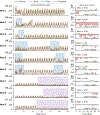Divergent Circadian Foraging Strategies in Response to Diurnal Predation Versus Persistent Rain in Asian Weaver Ant, Oecophylla smaragdina, Suggest Possible Energetic Trade-offs
- PMID: 38459718
- PMCID: PMC11139593
- DOI: 10.1177/07487304241233778
Divergent Circadian Foraging Strategies in Response to Diurnal Predation Versus Persistent Rain in Asian Weaver Ant, Oecophylla smaragdina, Suggest Possible Energetic Trade-offs
Abstract
The study of chronobiology of foraging behavior in social insects offers valuable models for the investigation of circadian rhythms. We scored hourly nest entries and exits of Oecophylla smaragdina (Asian weaver ant) workers in 9 active non-polydomous nests on days with and without rain and with and without a primarily diurnal predator present. After determining that Oecophylla display a high nest fidelity, we focused exclusively on analyzing nest entry counts: we found a significant decrease in overall entry counts of individual ants on rainy days compared with non-rainy days (p < 0.0001). They usually maintain a typical diurnal pattern of foraging activity; however, that regularity was often distorted during rainy periods but appeared to quickly revert to typical patterns following rain. This lack of compensatory foraging activity following a period of rain supports the hypothesis that these ants have enough food reserves to withstand a pure masking-induced suppression of foraging activity. Predation through bird anting, too, decreased foraging activity but appeared to cause a reversal in foraging activity timing from diurnal to nocturnal foraging. Daily periodicity of foraging was significantly disrupted in most nests during rain; however, daily foraging periodicity was disrupted in only one nest due to presence of predators. Thus, rain and predation both exert significant impacts on the overall foraging activity of Asian weaver ants, but while persistent pressure from rain seemed to primarily cause masking (diminution) of circadian foraging activity, predation restricted to the daytime resulted in phase-inversion to nocturnal foraging activity, with little diminution. This is consistent with different energetic strategies being used in response to different pressures by this species.
Keywords: Asian weaver ants; activity rhythm; fidelity foraging plasticity; masking; temporal niche plasticity.
Conflict of interest statement
Conflict Of Interest StatementThe authors have no potential conflicts of interest with respect to the research, authorship, and/or publication of this article.
Figures




Similar articles
-
A trophic cascade induced by predatory ants in a fig-fig wasp mutualism.J Anim Ecol. 2014 Sep;83(5):1149-57. doi: 10.1111/1365-2656.12219. Epub 2014 May 20. J Anim Ecol. 2014. PMID: 24666375
-
Elucidating the daily foraging activity pattern of Oecophylla smaragdina to minimize bite nuisances in Asia large agro-system plantations.Heliyon. 2024 Feb 18;10(4):e26105. doi: 10.1016/j.heliyon.2024.e26105. eCollection 2024 Feb 29. Heliyon. 2024. PMID: 38434038 Free PMC article.
-
The Antsy Social Network: Determinants of Nest Structure and Arrangement in Asian Weaver Ants.PLoS One. 2016 Jun 7;11(6):e0156681. doi: 10.1371/journal.pone.0156681. eCollection 2016. PLoS One. 2016. PMID: 27271037 Free PMC article.
-
Do predators influence the behaviour of bats?Biol Rev Camb Philos Soc. 2013 Aug;88(3):626-44. doi: 10.1111/brv.12021. Epub 2013 Jan 24. Biol Rev Camb Philos Soc. 2013. PMID: 23347323 Review.
-
Predators and the breeding bird: behavioral and reproductive flexibility under the risk of predation.Biol Rev Camb Philos Soc. 2009 Aug;84(3):485-513. doi: 10.1111/j.1469-185X.2009.00085.x. Biol Rev Camb Philos Soc. 2009. PMID: 19659887 Review.
Cited by
-
The cost of re-synchronization in a leaf-cutter ant colony.Commun Biol. 2025 Aug 7;8(1):1178. doi: 10.1038/s42003-025-08117-5. Commun Biol. 2025. PMID: 40775541 Free PMC article.
References
-
- Ali S and Ripley SD (1983) Handbook of the birds of India and Pakistan. Compact edition. Oxford University Press and BNHS, Mumbai.
-
- Ali S. and Ripley SD (1995). The Pictorial Guide to the Birds of Indian Sub-continent. Oxford University Press and BNHS, Mumbai.
-
- Baskaran ST (1992). Sighting of Dusky Horned Owl. Newsletter for Birdwatchers 32(9): 10.
-
- Ambika S and Nalini T (2019) Nest composition, inward and outward flows of Oecophylla smaragdina Fabricius (Hymenoptera: Formicidae) in selected fruit crops. Plant Archives 19(2): 2781–2784.
-
- Brown C and Braithwaite VA (2005) Effects of predation pressure on the cognitive ability of the poeciliid Brachyraphis episcopi. Behavioral Ecology 16(2). Oxford University Press: 482–487.
Publication types
MeSH terms
Grants and funding
LinkOut - more resources
Full Text Sources

